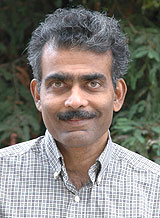November 27, 2006
Engineers participate in high-speed network demonstration
By
Tim Stephens
UCSC computer engineers contributed to a demonstration of high-speed networking technology by a team of industry leaders at an international conference in November. The team--including Finisar, Infinera, Internet2, Level 3 Communications, and UCSC--implemented the first demonstration of 100 Gigabit Ethernet (100GbE), successfully transmitting a signal at a rate of 100 billion bits per second.

Computer engineering professor Anujan Varma's group at UCSC designed the network interface for the demonstration project.
Photo: Tim Stephens
|
The demonstration showed that 100 GbE technology is viable and capable of implementation in existing optical networks.
Currently, the high-end Ethernet used in high-speed networking applications operates at 10 Gigabits per second (10 Gb/s). As the Internet is increasingly used for transmitting large video files and other bandwidth-hungry applications, the need for higher-speed Ethernet will grow, said Anujan Varma, professor of computer engineering.
"Today we have plenty of capacity, but the Internet is on the cusp of a revolution driven by video-based applications, and that's what is going to drive the next generation of networking technology," Varma said.
Varma's group at UCSC designed the network interface, called a medium access controller (MAC), for the demonstration project. The system successfully transmitted a 100 Gigabit packet stream from Tampa, Florida, to Houston, Texas, and back again, over ten 10 Gb/s channels through the Level 3 network. This was the first time a 100 Gb packet stream has been successfully transmitted through a live production network. The demonstration took place at the annual SC06 International Conference on High-Performance Computing, Networking, Storage, and Analysis in Tampa.
"100 Gigabit Ethernet will be a critical technology to accommodate bandwidth growth, and this demonstration shows that we have the capability to implement this as a super-lambda service over today's networks," said Infinera cofounder and chief technical officer Drew Perkins.
Finisar provided the optical transceivers for the demonstration, Infinera provided the dense wavelength division multiplexing (DWDM) system and project management, Internet2 was involved in developing the methodology and supporting the demonstration, Level 3 Communications provided the ten 10 Gb/s channels from Tampa to Houston, and UCSC designed and implemented the network interface including the packet resequencing scheme.
The research and education community is a leader in creating very large flows of data on the Internet, with some research institutions planning on flows in multiple hundreds of Gigabits per second or even Terabits per second. Advanced videoconferencing, telemedicine, and high-performance grid computing are among the applications that will require increased bandwidth, said Steve Cotter, director of network services for Internet2.
Establishing an industry standard for the next-generation Ethernet is an important next step, Varma said. The IEEE Higher Speed Study Group (HSSG) recently began working on specifications for higher speed Ethernet, and the partners in this demonstration are actively supporting these efforts. The pre-standard specification used in this demonstration was jointly developed by Infinera and the UCSC team including Varma and graduate student Arvinderpal Wander.